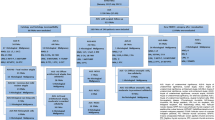Abstract
Argyrophilic nucleolar organizing region associated proteins (AgNORs) have been shown to be of interest in a variety of different diseases including thyroid disorders. Our aim was to distinguish benign thyroid lesions from papillary thyroid carcinoma (PTC) via AgNOR count and with a new approach, via AgNOR surface area/total nuclear surface area (NORa/TNa) proportions in the nuclei on fine-needle aspiration (FNA) materials. Thirty patients (eight men and 22 women) whose FNA was compatible with benign lesion and 26 patients (eight men and 18 women) whose FNA was compatible with PTC were included in the study. Fine-needle aspiration materials were stained for AgNOR detection according to a specific protocol. One hundred nuclei per individual have been evaluated, and AgNOR number and NORa/TNa proportions of individual cells were measured and calculated by using a computer program. Patients with PTC had significantly (p < 0.001) higher AgNOR count (4.6 ± 1.2%) than in the patients with benign lesions (2.0 ± 0.5%). Additionally, patients with PTC had significantly (p < 0.001) higher NORa/TNa (13.4 ± 2.4) than in the patients with benign lesion (5.7 ± 1.0). Modified method of AgNOR staining is an easy and reliable method for evaluating proliferation activity of cells in malignant and benign thyroid lesions and it may contribute to routine cytopathology in inconclusive situations.



Similar content being viewed by others
References
Hernandez-Verdun D & Louvet E. The nucleolus: structure, functions and associated diseases. Medical Sciences 20:37–44, 2004.
Trere D. AgNOR staining and quantification. Micron 31:127–131, 2000.
Imamoglu N, Demirtas H, Donmez-Altuntas H, et al. Higher NORs–expression in lymphocyte of trisomy 21 babies/children: in vivo evaluation. Micron 36:503–507, 2005.
Nairn ER, Crocker J & Mcgovern J. Limited value of AgNOR enumeration in assesment of thyroid neoplasms. Journal of Clinical Pathology 41:1136, 1988.
Crocker J & Nar P. Nucleolar organizer regions in lymphomas. Journal of Pathology 151:111–118, 1987.
Abboud P, Lorenzato M, Joly D, et al. Prognostic value of a proliferation index including MIB1 and argyrophilic nucleolar organizer regions proteins in node-negative breast cancer. American Journal of Obstetrics and Gynecology 199:146–150, 2008.
Derenzini M, Ceccarelli C, Santini D, et al. The prognostic value of the AgNOR parameter in human breast cancer depends on the pRb and p53 status. Journal of Clinical Pathology 55:755–761, 2004.
Cardillo MR. AgNOR counts are useful in cervical smears. Diagnostic Cytopatholgy 8:208–210, 1992.
Howat AJ, Giri DD, Cotton DW, et al. Nucleolar organizer regions in Spitz nevi and malignant melanomas. Cancer 63:474–478, 1989.
Cibas ES, & Ali SZ. NCI Thyroid FNA State of the Science Conference. The Bethesda System For Reporting Thyroid Cytopathology. American Journal of Clinical Pathology 132:658–665. 2009.
Benn PA & Perle M. Chromosome staining and banding techniques. In: Rooney D.E. Czepulkowski BH. (eds). Human Cytogenetics, Constitutional Analysis, actical approach, Vol 1. Oxford Univ. Press 91–118, 1986
Lindner LE. Improvements in the silver-staining technique for nucleolar organizer regions (AgNOR). Journal of Histochemistry and Cytochemistry 41:439–445, 1993.
Demirtas H, Imamoglu N, Donmez H, et al. Condensed chromatin surface and NOR surface enhancement in mitogen-stimulated lymphocytes of Down syndrome patients. Ann Genet-Paris 44:77–82, 2001.
Pich A, Chiusa L, Navone R. Prognostic relevance of cell proliferation in head and neck tumours. Annals of Oncology 15:1319–1329, 2004.
Jones AS. Prognosis in mouth cancer: tumour factors. European Journal of Cancer Part B Oral Oncolog 30:8–15, 1994.
Underwood JC. AgNOR measurements as indices of proliferation, ploidy and prognosis. Clinical Molecular Pathology 48:M239-M240, 1995.
Bukhari MH, Niazi S, Hashmi I, et al. Use of AgNOR index in grading and differential diagnosis of astrocytic lesions of brain. Pakistan Journal of Medical Sciences 23:206–210, 2007.
Camargo R.S., Shirata N.K., di Loreto C, et al. Significance of AgNOR measurement in thyroid lesions. Analysis and Quantitative Cytology and Histology 28:188–192, 2006.
Slowinska-Klencka D, Klencki M, Popowicz B, et al. AgNOR quantification in the diagnosis of follicular pattern thyroid lesions. Analysis and Quantitaive Cytology and Histology 25:347–352, 2003.
Slowi’nska-Klencka D, Klencki M, Popowicz B, et al. Multiparameter analysis of AgNOR in thyroid lesions: comparison with PCNA expression. Histol Histopathol 19:785–792, 2004.
Augustynowicz A, Dzieciol J, Dadan J, et al. Proliferative activity of the thyroid oxyphilic tumor cells estimated by means of quantitative analysis of silver stained nucleolar organizer regions (AgNORs). Folia Histochemica et Cytobiologica 39:(Suppl 2) 203–204, 2001.
Dernburg AF & Misteli T. Nuclear architecture an island no more. Devolepmental Cell 12:329–34, 2007.
Misteli T. Concepts in nuclear architecture. Bioessays 27:477–487, 2005.
Zink D, Fischer AH & Nickerson JA. Nuclear structure in cancer cells. Nature Reviews Cancer 4:677–687, 2004.
Zaidi SK, Young DW, Javed A, et al. Nuclear microenvironments in biological control and cancer. Nature Reviews Cancer 7:454–463, 2007.
Gilbert DM & Zink D. Intranuclear changes in cancer cells. Genome Biology 8:312, 2007.
Derenzini M, Pasquinelli G, O’Donohue MF, et al. Structural and functional organization of ribosomal genes within the mammalian cell nucleolus. Journal of Histochemistry and Cytochemistry 54:131–145, 2006.
Eroz R, Cucer N, Unluhizarci K, et al. Evaluation of AgNOR spot number in thyroid papillary carcinoma and normal cells nuclei. Journal of Health Sciences 19 (2):102–107, 2010.
Funding
The Medical Research Council of Erciyes University (ERUBAP, Project No. B-538) supported this work.
Declaration of interest
There is no conflict of interest that could be perceived as prejudicing the impartiality of the research reported.
Author information
Authors and Affiliations
Corresponding author
Rights and permissions
About this article
Cite this article
Eroz, R., Cucer, N., Karaca, Z. et al. The Evaluation of Argyrophilic Nucleolar Organizing Region Proteins in Fine-Needle Aspiration Samples of Thyroid. Endocr Pathol 22, 74–78 (2011). https://doi.org/10.1007/s12022-011-9161-z
Published:
Issue Date:
DOI: https://doi.org/10.1007/s12022-011-9161-z




